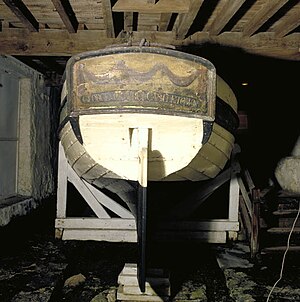This article has multiple issues. Please help improve it or discuss these issues on the talk page. (Learn how and when to remove these messages)
|
 Peggy of Castletown, Isle of Man
| |
| History | |
|---|---|
| Cost | £47.3.1½ |
| Launched | 1789 |
| General characteristics | |
| Length | 26+1⁄2 ft (8.1 m) (LOA) |
| Beam | 7 ft 8 in (2.34 m) |
| Depth | 4 ft (1.2 m) |
| Sail plan | schooner rigged |
| Armament | 4 cannon & 2 stern chasers |
Peggy is an armed yacht built in June, 1789[1] for George Quayle (1751–1835), MHK, a prominent politician and banker on the Isle of Man. She is the oldest surviving Manx craft and is one of only a very few surviving vessels built in the 18th century.
For over one hundred years following Quayle's death, Peggy was interred within the boathouse he built for her, effectively forgotten. Interest in her grew during the 20th century, and after WWII she was given to the people of the Isle Man to be held in trust by Manx National Heritage. She remains preserved in the boathouse, now part of The Nautical Museum in Castletown, on the Isle of Man.
She is clinker-built and was schooner rigged with a bowsprit.[2] A set of her spars is preserved with her, along with her armaments (six cannon and two stern chasers) and the winding gear employed to draw her into the boathouse. She is the oldest surviving schooner in the world and the oldest surviving example of the shallop hull form. She was fitted with sliding keels (progenitors of the modern daggerboard) not long after the invention of the technology by John Schank,[3] and she is the oldest surviving example of such a vessel.
Well-known correspondence between George Quayle and his brother, in the Manx National Archive, describes an expedition in 1796 over sea and land to Windermere, Peggy's victory in a regatta there, and her perilous journey home, aided by her sliding keels.
Peggy has been surveyed three times, first by P.J. Oke in 1935 of the Society for Nautical Research (drawings now residing at the National Maritime Museum in Greenwich, London), then by Mr Richard Cowley of Kirk Michael, Isle of Man, and most recently in 1968 by D. K. Jones at the behest of Manx National Heritage. Basil Greenhill, then Director of the National Maritime Museum, took a keen interest in her around this time.[4][5][6][7] Peggy is now recognized as a vessel of international significance, which is reflected in her citation on the UK National Historic Ships Register (National Historic Fleet). Her well-documented provenance, her fine state of relative preservation, her historic location and her design all contribute to this.
- ^ Manx Museum and National Trust MNH MS 940/1C
- ^ "Peggy". National Historic Ships (UK). Retrieved 2012-07-21.
- ^ O'Brian, P. (2010) Post Captain, Harper, p. 175. ISBN 0-00-649916-3
- ^ Greenhill, Basil (1967) "The Schooner Peggy: Eighteenth-century Survival at the Nautical Museum, Castletown". Journal of the Manx Museum. Volume 3, pp. 68-76
- ^ Greenhill, Basil (1967) "The Schooner Peggy: An Eighteenth-Century Survival". The American Neptune. January. pp.54-61
- ^ MacGregor, D. R. (1997) The Schooner. Its Design and Development from 1600 to the Present. Chatham Publishing;
- ^ Salisbury, W. (1963) "The schooner Peggy of 1789 and her boathouse". The Mariner's Mirror. Vol.49 No.2.